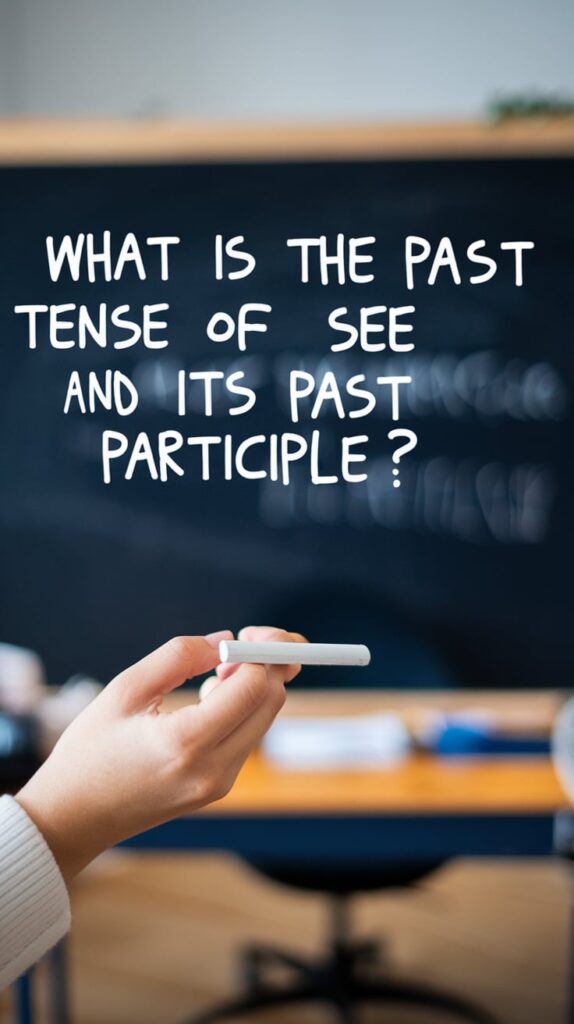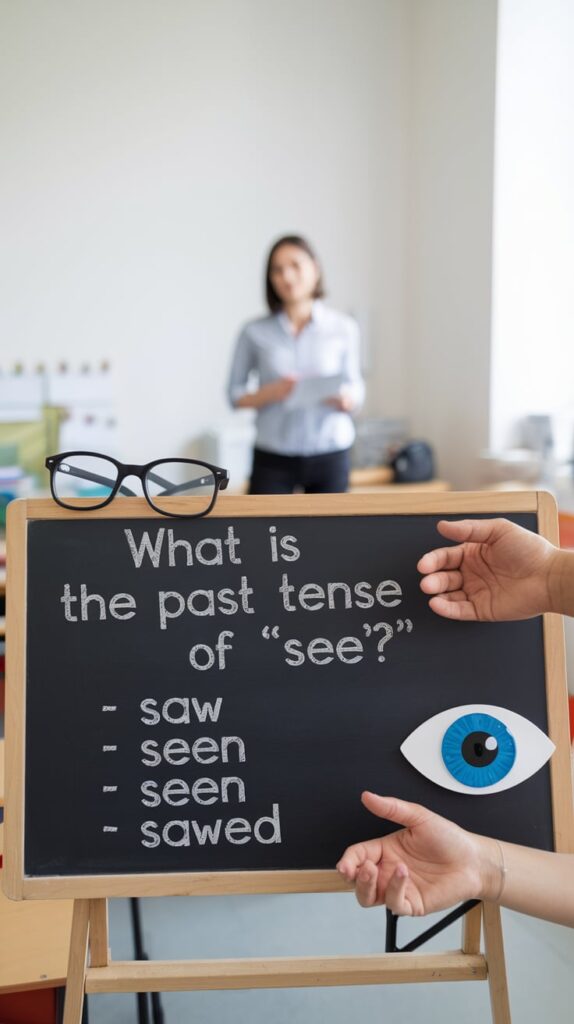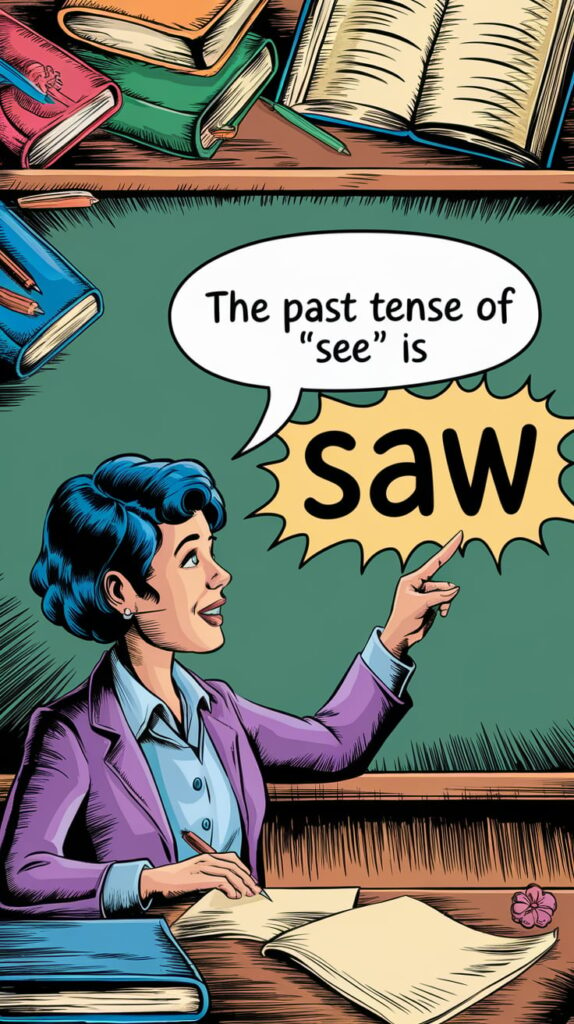Have you ever found yourself stumbling over whether to say “I saw” or “I have seen”? You’re not alone! The verb “see” trips up even native English speakers.
In this comprehensive guide, we’ll dive deep into the past tense and past participle forms of this tricky irregular verb, making sure you’ll never second-guess yourself again.
read more : Cacoon vs Cocoon Spelling – Grammar Beacon
Why Understanding “See” Matters in English Grammar
Before we dive into the nitty-gritty details, let’s talk about why mastering these verb forms is crucial. In the realm of English language, few skills are as important as being able to accurately describe past events and experiences.

When you’re telling a story, writing an email, or crafting a report, using the correct form of “see” can make the difference between sounding professional and appearing unsure.
read more : “Totalling” vs. “Totaling”: Navigating the Spelling Dilemma – Grammar Beacon
“The difference between the right word and the almost right word is the difference between lightning and a lightning bug.” – Mark Twain
The Journey from Present to Past: Understanding “See” to “Saw”
Present Tense: Starting with “See”
In its basic form, “see” is what grammarians call the infinitive form. We use it for:
- Present simple actions: “I see a bird.”
- Habitual actions: “She sees her therapist every Tuesday.”
- Future arrangements: “I see the doctor next week.”
Simple Past: Introducing “Saw”
When we move into the realm of past events, “see” transforms into “saw.” This is where many learners of English grammar first encounter challenges. Let’s break it down:
Common uses of “saw”:
- Completed actions: “I saw the movie last night.”
- Specific past experiences: “We saw the Eiffel Tower on our vacation.”
- Sequential events: “He saw the car coming and jumped out of the way.”
Here’s a handy table to showcase the transformation:
| Time Frame | Verb Form | Example |
| Present | See | I see stars tonight |
| Past | Saw | I saw stars last night |
Real-World Applications of “Saw”
To truly understand how to use “saw,” let’s look at some practical scenarios:
Storytelling
“Last summer, I saw the most amazing sunset.”
“She saw her old friend at the reunion.”
Reporting Past Events
“The witness saw the accident happen.”
“Scientists saw significant improvements in the test results.”
Describing Past Experiences
“I saw that movie when it first came out.”
“They saw potential in the young athlete.”
read more : Other Ways to Say Thank You For Responding Quickly – Grammar Beacon

The Past Participle: Mastering “Seen”
Now we enter the territory that causes the most confusion: the past participle “seen.” This form is used in perfect tenses and requires helping verbs like have, has, or had.
When to Use “Seen”
Present Perfect
Used for: Experiences up to the present moment
Structure: have/has + seen
Example: “I have seen that show three times.”
Past Perfect
Used for: Actions completed before another past action
Structure: had + seen
Example: “By the time the movie started, I had seen all the trailers.”
Future Perfect
Used for: Actions that will be completed by a future point
Structure: will have + seen
Example: “By next month, I will have seen all the episodes.”
read more : Other Ways to Say Thank You for Your Attention – Grammar Beacon
Common Contexts for “Seen”
Let’s explore some everyday situations where you’d use “seen”:
Life Experiences
– “Have you ever seen the Northern Lights?”- “I’ve seen many changes in this neighborhood.”
Work Contexts
– “We’ve seen a significant increase in productivity.”- “The team had seen similar issues before.”

Entertainment
– “She hasn’t seen the latest episode yet.”- “They had seen the play twice before.”
Avoiding Common Mistakes
Even native speakers sometimes struggle with verb usage when it comes to “see.” Here are the most common pitfalls and how to avoid them:
Mistake #1: Using “Seen” Without a Helping Verb
❌ Incorrect: “I seen the game yesterday.” ✅ Correct: “I saw the game yesterday.” or “I have seen the game.”
Mistake #2: Mixing Up “Saw” and “Have Seen”
❌ Incorrect: “I have saw the movie.” ✅ Correct: “I have seen the movie.”
Mistake #3: Inconsistent Tense Usage
❌ Incorrect: “When I seen him, he was running.” ✅ Correct: “When I saw him, he was running.”
Memory Tricks and Learning Strategies
To maintain proper tense consistency, try these helpful memory aids:
The Solo Rule
If the verb stands alone, use “saw”
Example: “I saw a shooting star.”
The Helper Rule
If you have a helping verb (have/has/had), use “seen”
Example: “I have seen this before.”
The Rhyme Method
“If it’s alone, let ‘saw’ be shown, With ‘have’ or ‘had,’ use ‘seen’ instead!”
Beyond Basic Usage: Advanced Applications
Idiomatic Expressions
The true mastery of English language includes understanding idioms that use different forms of “see”:

Using “See”
“I’ll see to it” (meaning: I’ll take care of it)
“Let’s see how it goes” (meaning: let’s wait and observe)
Using “Saw”
“I saw red” (meaning: became very angry)
“Never saw it coming” (meaning: didn’t expect it)
Using “Seen”
“I’ve seen better days” (meaning: things have been better)
“Haven’t seen hide nor hair” (meaning: haven’t seen any trace of someone)
Formal vs. Informal Usage
Understanding how to adjust your verb usage past tense of see based on context is crucial:
Formal Settings:
- “We have seen remarkable progress in the project.”
- “The committee saw fit to approve the proposal.”
Informal Settings:
- “Seen any good movies lately?”
- “I saw what you did there!”
Practical Exercises for Mastery
Let’s put your knowledge to the test with some grammar exercises:
Exercise 1: Fill in the Blanks
- Last week, I _ (see) a great documentary.
- Have you ever _ (see) a shooting star?
- By the time we arrived, they had _ (see) all the attractions.
Exercise 2: Sentence Transformation

Change these sentences to use different forms of “see”:
Original: “I see the problem.”
- Past tense: ___
- Present perfect: ___
- Past perfect: ___
(Answers at the end of the article!)
The Impact of Technology on Language Learning
In today’s digital age, mastering verb forms past tense of see has become easier than ever. Here are some tech tools to help you practice:
Language Learning Apps
Duolingo: Offers targeted practice
Grammarly: Helps catch mistakes in writing
Online Resources
YouTube tutorials
Interactive grammar websites
Digital Flashcards
Create custom cards for different verb forms
Use spaced repetition for better retention
Regional Variations in Usage
While standard grammar rules apply globally, you might encounter some regional differences:
American English
Tends to use simple past more frequently
“I saw that movie already.”
British English
Often prefers present perfect
“I’ve seen that movie already.”

Quick Reference Chart
For easy reference, here’s a comprehensive breakdown:
| Tense Form | Structure | Example | Usage |
| Present Simple | See | I see birds | Current actions |
| Past Simple | Saw | I saw birds | Completed past actions |
| Present Perfect | Have/Has seen | I have seen birds | Past with present relevance |
| Past Perfect | Had seen | I had seen birds | Past before another past |
| Future Perfect | Will have seen | I will have seen birds | Completed future actions |
Special Applications in Writing
Understanding how to use these verb forms of past tense of see effectively can enhance your writing:
Creative Writing
Use “saw” for action sequences
Use “had seen” for backstory
Academic Writing
“As seen in the data…”
“Previous studies have seen similar results…”
Professional Writing
“We saw a 20% increase in sales.”
“The company has seen significant growth.”
Conclusion: Seeing Clearly Now
Mastering the past tense and past participle of “see” might seem daunting at first, but with practice and understanding, it becomes second nature. Remember:
- Use “saw” for simple past actions
- Use “seen” with helping verbs
- Context is key in choosing the right form
Whether you’re a student, professional, or language enthusiast, proper verb usage enhances your communication skills and credibility.
Answers to Exercises:
Exercise 1:
- saw
- seen
- seen
Exercise 2:
- I saw the problem.
- I have seen the problem.
- I had seen the problem.
Final Thoughts
As you continue your journey in English language learning, remember that even native speakers sometimes struggle with these distinctions. The key is practice and exposure. The more you use these forms in context, the more natural they’ll become.
“Language is the road map of a culture. It tells you where its people come from and where they are going.” – Rita Mae Brown
Now that you’ve seen (pun intended!) all there is to know about the past tense of “see,” you’re well-equipped to use it correctly in any situation. Keep practicing, and soon you’ll see the results!

James Logan is a seasoned blogger and language enthusiast behind Grammar Beacon. With years of experience in grammar and writing, James shares his expertise through insightful and engaging content. His passion for clear communication and linguistic precision shines in every post, making complex grammar concepts accessible and enjoyable for readers. Follow James for expert advice and tips to refine your writing skills.







